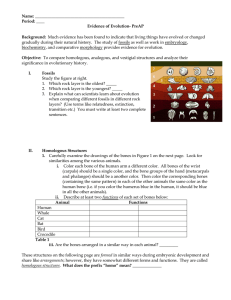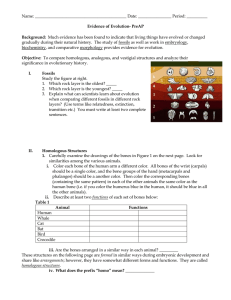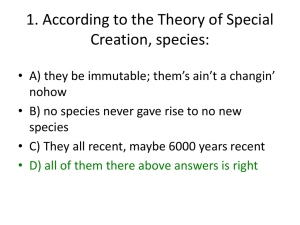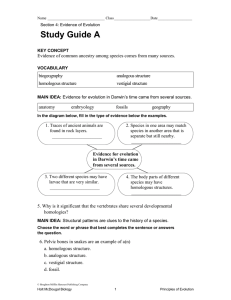Evidence of Evolution Lab Background
advertisement
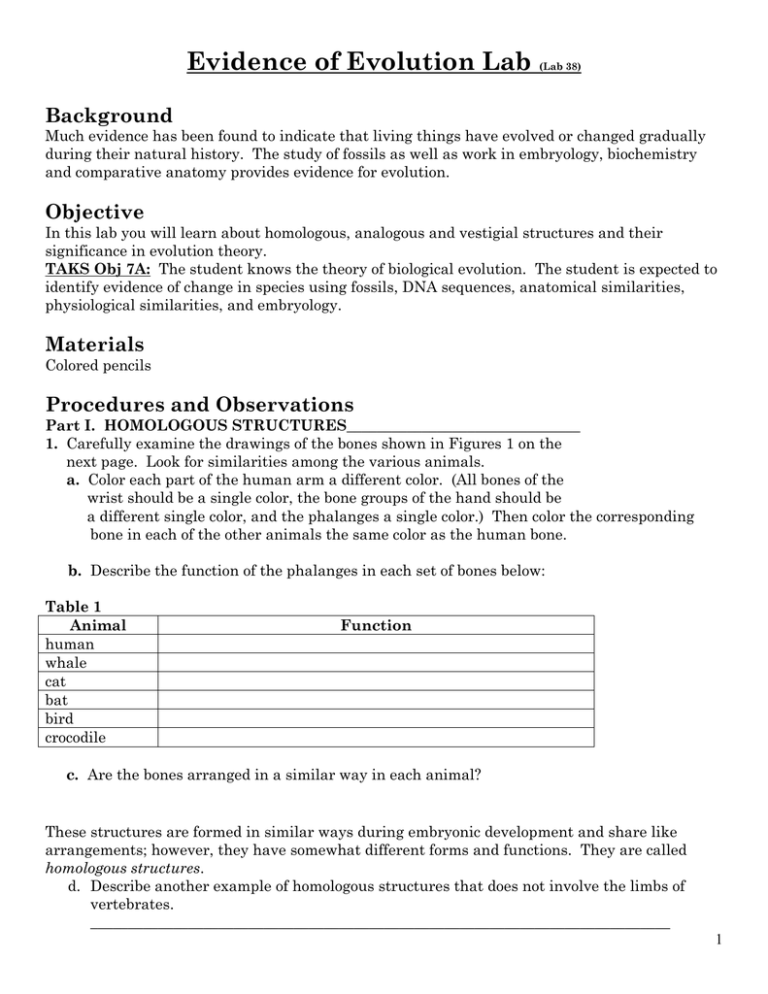
Evidence of Evolution Lab (Lab 38) Background Much evidence has been found to indicate that living things have evolved or changed gradually during their natural history. The study of fossils as well as work in embryology, biochemistry and comparative anatomy provides evidence for evolution. Objective In this lab you will learn about homologous, analogous and vestigial structures and their significance in evolution theory. TAKS Obj 7A: The student knows the theory of biological evolution. The student is expected to identify evidence of change in species using fossils, DNA sequences, anatomical similarities, physiological similarities, and embryology. Materials Colored pencils Procedures and Observations Part I. HOMOLOGOUS STRUCTURES_______________________________ 1. Carefully examine the drawings of the bones shown in Figures 1 on the next page. Look for similarities among the various animals. a. Color each part of the human arm a different color. (All bones of the wrist should be a single color, the bone groups of the hand should be a different single color, and the phalanges a single color.) Then color the corresponding bone in each of the other animals the same color as the human bone. b. Describe the function of the phalanges in each set of bones below: Table 1 Animal human whale cat bat bird crocodile Function c. Are the bones arranged in a similar way in each animal? These structures are formed in similar ways during embryonic development and share like arrangements; however, they have somewhat different forms and functions. They are called homologous structures. d. Describe another example of homologous structures that does not involve the limbs of vertebrates. _____________________________________________________________________________ 1 Analysis and Interpretations 1. Explain why the homologous structures in Part I are evidence of evolutionary relationships. 2 Part II. ANALOGOUS STRUCTURES_________________________________ 1. Examine the butterfly wing and the bird wing shown in Figure 2. a. What function do these structures share? b. How do the structures differ? c. Do birds and insects share any structural similarities that would suggest they are closely related taxonomically? Some apparently unrelated animals have organs with similar functions, yet are very different in structure and form, and do not come from the same embryological tissues. These structures are called analogous structures. d. Describe another example of analogous structures that does not involve wings. ____________________________________________________________________________________ Analysis and Interpretations 1. Explain the evolutionary relationship between the fin of a bony fish and the flipper of a whale. 3 Part III. VESTIGIAL STRUCTURES__________________________________ Gradual changes have occurred through time that have in some cases reduced or removed the function of some body structures and organs. The penguin’s wings and the leg bones of snakes are examples of this phenomenon. 1. The cave fish and minnow show in Figure 3 are related, but the cave fish is blind. a. Explain why eyesight is not an important adaptation to life in a cave. a. Does the appearance of the cave fish and minnow suggest common ancestry? Why? Organs or structures that have lost their function in the organism and become reduced in size (because of efficiency) are called vestigial structures. Human vestigial organs are well documented. b. Describe another example of a vestigial structure that is not mentioned in this lab. ______________________________________________________________________ 2. Read the list of human vestigial structures shown in Table 2. a. Suggest a possible function for each structure and explain why it became vestigial. Record your answers in the table. In the last row, identify an additional human vestigial structure and its function. Table 2. Human Vestigial Structures & Their Functions Structure Probable Function Why Vestigial? Not needed as we moved to a more appendix digestion refined diet; previously probably the cecum – found only in herbivores for digesting cellulose with the aid of bacteria coccyx (tail bone) muscles that move ears muscles that make hair stand up little toe wisdom teeth 4 Discussion & Conclusions Anatomical evidence for evolution includes 3 different types of structures. 1) Identify and describe all three types of structures 2) Elaborate on your description by explaining at least one example not previously described in this lab 3) Explain how observations of these 3 types of structures provide evidence of evolution (a change in the gene frequency of a population over time) through natural selection (survival of the fittest; the theory that organisms that are the best adapted to their environment will have more offspring that will survive to reproduce – a measure of reproductive fitness) ___________________________________________________________________ ___________________________________________________________________ ___________________________________________________________________ ___________________________________________________________________ ___________________________________________________________________ ___________________________________________________________________ ___________________________________________________________________ ___________________________________________________________________ ___________________________________________________________________ ___________________________________________________________________ ___________________________________________________________________ ___________________________________________________________________ ___________________________________________________________________ ___________________________________________________________________ ___________________________________________________________________ ___________________________________________________________________ ___________________________________________________________________ ___________________________________________________________________ ___________________________________________________________________ ___________________________________________________________________ ___________________________________________________________________ ___________________________________________________________________ ___________________________________________________________________ ___________________________________________________________________ ___________________________________________________________________ ___________________________________________________________________ 5 ___________________________________________________________________ ___________________________________________________________________ ___________________________________________________________________ ___________________________________________________________________ ___________________________________________________________________ ___________________________________________________________________ ___________________________________________________________________ ___________________________________________________________________ ___________________________________________________________________ ___________________________________________________________________ ___________________________________________________________________ ___________________________________________________________________ ___________________________________________________________________ ___________________________________________________________________ ___________________________________________________________________ ___________________________________________________________________ ___________________________________________________________________ ___________________________________________________________________ ___________________________________________________________________ ___________________________________________________________________ ___________________________________________________________________ ___________________________________________________________________ ___________________________________________________________________ ___________________________________________________________________ ___________________________________________________________________ ___________________________________________________________________ ___________________________________________________________________ ___________________________________________________________________ ___________________________________________________________________ ___________________________________________________________________ ___________________________________________________________________ ___________________________________________________________________ ___________________________________________________________________ ___________________________________________________________________ ___________________________________________________________________ 6

